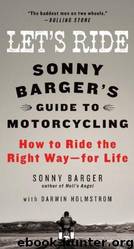Let's Ride: Sonny Barger's Guide to Motorcycling by Sonny Barger; Darwin Holmstrom

Author:Sonny Barger; Darwin Holmstrom
Language: eng
Format: mobi
Tags: Repair & Maintenance, Automotive, Transportation, Motorcycles, General
ISBN: 9780061964275
Publisher: HarperCollins
Published: 2011-07-26T09:54:49+00:00
What Do Dents Mean?
Be sure to look for dents and other signs of crashing. A small ding on an exhaust pipe, footpeg tip, or clutch lever likely means a bike has fallen over, but that isn’t necessarily a deal breaker. Motorcycles are inherently unstable machines, and as such they are prone to falling over. Sooner or later, every bike will fall over. A kickstand will sink into the asphalt on a hot day, or you might hit a slick patch of diesel while rolling up to a gas pump just as you happen to be crossing a rough seam in the pavement. Shit happens. The vast majority of these parking-lot tip overs result in such minor cosmetic damage that it’s not worth fixing, but they do leave telltale marks on the machine.
Also, don’t worry about stone chips on the fenders or the frame behind the front wheel. This is natural wear and tear and is unavoidable if the bike is to be ridden in the real world. The only bikes without stone chips are brand-new ones sitting on showroom floors or useless trailer queens hauled from bike show to bike show. All of my bikes have fallen over more than once, and each of them have pitted chrome and paint from rocks and road debris. If you ride forty thousand miles or more each year, your bikes will be pitted too.
Bigger dents are usually signs of more serious crashes that can have more dire consequences to the motorcycle’s structural integrity. If a bike took a hit that was hard enough to put a grapefruit-sized divot in the gas tank, chances are the parts that you can’t see took a hard hit, too. At the very least it indicates that the owner didn’t treat his or her bike with the respect it deserved.
If a bike has plastic bodywork like a fairing, saddlebags, or a trunk, even a minor tip over can have much more expensive consequences. Check to make sure that all the gaps in the body panels have a uniform fit and all the tabs holding the parts together are intact and not broken off. Examine all the plastic for cracks. Even if the plastic isn’t cracked, spiderweb cracks in the paint around mounting bolts are a sign that the bike has been through some sort of traumatic event. This will also show up in the metal mounting brackets that hold the bodywork in place. Visually inspect all the plastic pieces to ensure they line up straight; if they sit crooked, something underneath them is probably bent, which could be a very bad thing.
Even if the plastic pieces appear straight, examine the brackets holding them in place (at least the ones you can see) to make sure they aren’t bent or tweaked. Even if the brackets are straight, examine them for evidence that they have been straightened. This is a sign that the bike has been in a serious crash.
Check the seat cover for rips and tears. The stitching should line up, and everything should be straight.
Download
This site does not store any files on its server. We only index and link to content provided by other sites. Please contact the content providers to delete copyright contents if any and email us, we'll remove relevant links or contents immediately.
| Buyers' Guides | Classic Cars |
| Customize | Driver's Education |
| Electric & Hybrid | Foreign |
| History | Industry |
| Insurance | Luxury |
| Motorcycles | Pictorial |
| Racing | Repair & Maintenance |
| Trucks & Vans |
Machine Learning at Scale with H2O by Gregory Keys | David Whiting(3574)
Never by Ken Follett(3513)
Urban Outlaw by Magnus Walker(3235)
OPNsense Beginner to Professional by Julio Cesar Bueno de Camargo(3189)
Sapiens and Homo Deus by Yuval Noah Harari(2838)
Will by Will Smith(2568)
A Short History of Nearly Everything by Bryson Bill(2503)
Hooked: A Dark, Contemporary Romance (Never After Series) by Emily McIntire(2407)
Rationality by Steven Pinker(2145)
Borders by unknow(2114)
Holy Bible (NIV) by Zondervan(2022)
The Becoming by Nora Roberts(1906)
The One Percenter Encyclopedia by Bill Hayes(1712)
Freedom by Sonny Barger(1710)
HBR's 10 Must Reads 2022 by Harvard Business Review(1693)
A Short History of War by Jeremy Black(1665)
Five Ways to Fall by K.A. Tucker(1629)
Girls Auto Clinic Glove Box Guide by Patrice Banks(1613)
Go Tell the Bees That I Am Gone by Diana Gabaldon(1592)
